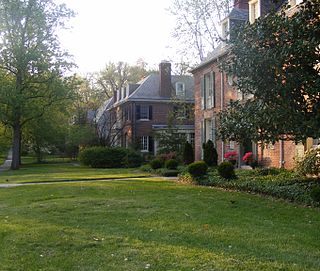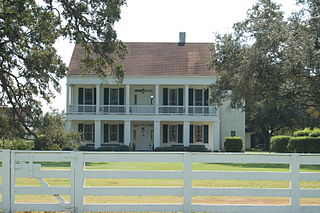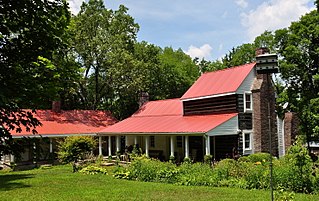
Turkey Run State Park, Indiana's second state park, is in Parke County in the west-central part of the state along State Road 47, 2 miles (3.2 km) east of U.S. 41. The first parcel of land was purchased for $40,200 in 1916, when Indiana's state park system was established during the state's centennial anniversary of its statehood. The origin of the name "Turkey Run" is unknown, but the most accepted theory is that wild turkeys would congregate for warmth in the gorges, where early settlers could easily trap and hunt them. The Lusk Home and Mill Site and the Richard Lieber Log Cabin within the park's grounds were included as individual sites on the National Register of Historic Places in 1974 and 2001, respectively. The park itself was listed on the National Register of Historic Places in 2019. Turkey Run also includes a system of trails, Rocky Hollow Falls Canyon Nature Preserve, a suspension bridge across Sugar Creek, camping sites and other recreational areas. The Turkey Run Inn was built in 1919. Several guest cabins near the inn date from the 1930s and 1940s.

Lower Brandon Plantation is located on the south shore of the James River in present-day Prince George County, Virginia.
Richard Boone Cheatham was an American politician based in Nashville, Tennessee. He was serving as the mayor of Nashville, Tennessee during the opening years of the Civil War. After the war he served as alderman of the city, and later as a representative to the State House, 1869-1871.

Guilford is a prominent and historic neighborhood located in the northern part of Baltimore, Maryland. It is bounded on the south by University Parkway, on the west by North Charles Street, Warrenton and Linkwood Roads, on the north by Cold Spring Lane and on the east by York Road. The neighborhood is adjacent to the neighborhoods of Tuscany-Canterbury, Loyola-Notre Dame, Kernewood, Wilson Park, Pen Lucy, Waverly Oakenshawe, Charles Village, and the universities of Johns Hopkins and Loyola University Maryland. The neighborhood was added to the National Register of Historic Places in 2001.

Blakeley, near Charles Town, West Virginia is also known as the Washington - Chew - Funkhouser House, and was built in 1820 by John Augustine Washington II, great-nephew of George Washington and grandson of John Augustine Washington. It is a contemporary of its neighbor, Claymont Court, built across Bullskin Run by John's brother, Bushrod Corbin Washington. John Washington did not attempt to match the grandeur of Claymont Court, as he was in line to inherit Mount Vernon, and did so in 1829.

The Allen-Beville House is a historic house on the Little Neck peninsula in the Douglaston neighborhood of Queens, New York City. Constructed between 1848–1850, it is one of the few surviving 19th century structures in Queens built as a farmhouse that survives.

The Cornelius Van Wyck House is an 18th-century Dutch Colonial home located on the shore of Little Neck Bay in the Douglaston section of Queens in New York City. This house overlooks Little Neck Bay and is well known for both its age and architecture, and especially for its original owners. It was designated as a landmark by the New York City Landmarks Preservation Commission in 1966 and added to the National Register of Historic Places in 1983. The Cornelius Van Wyck House is considered to be the "most impressive architectural remnant of the early Dutch Culture" in New York.
Edward Saunders Cheatham was an American politician and businessman.

The Cocke-Martin-Jackson House is a historic mansion in Brandon, Mississippi, USA.

Mulberry Grove is a historic mansion in Donaldsonville, Louisiana, U.S.. It was designed in the Greek Revival architectural style, and it was built in 1836 for Dr Duffel.

Ashcrest Farm is a historic mansion in Hendersonville, Tennessee, U.S.. Designed in the Classical Revival architectural style, it was built by slaves before the American Civil War and black laborers after the war. The land has been owned by the same family since 1810. Today, it is a horse farm.

The Hall-Harding-McCampbell House is a historic mansion in Nashville, Tennessee, U.S..
Dozier Farm, also known as Cliffview Farm, is a historic mansion in Nashville, Tennessee, U.S..

The Dr. Benjamin Franklin Smith House is a historic house in Waco, Tennessee, U.S..

The Benajah Gray Log House is a historic loghouse in Antioch, Tennessee, U.S..

The McCrory-Mayfield House is a historic log house in Brentwood, Tennessee, U.S.. It was built in 1798 for Thomas McCrory, a settler. It was purchased by William B. Carpenter in 1837. After the American Civil War, it was inherited by his daughter Mary and her husband, George Mayfield, in 1869. It stayed in the Mayfield family until 1939. It has been listed on the National Register of Historic Places since December 27, 1982.

The Andrew Scott House is a historic two-story farmhouse in Culleoka, Tennessee, U.S.

The Prewitt-Amis-Finney House, also known as Turnhill Farm, is a historic three-story house in Culleoka, Tennessee, U.S.. Built for the slaveholding Prewett family in 1810, it was established as a mule farm. It is located a few miles away from Columbia, and it overlooks Fountain Creek.

The Samuel R. Pitts Plantation, also known as the Greenwood Plantation or the William J. Benton House, is a historic house on a plantation in Pittsview, Alabama, U.S..

The Richard Mansfield House is a historic house at 35 Jewett Street in Ansonia, Connecticut. Built at the turn of the 17th-century, it is one of the community's oldest surviving buildings, and is noted for its association with a prominent early Episcopal minister. It was listed on the National Register of Historic Places in 1971.















